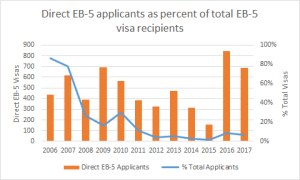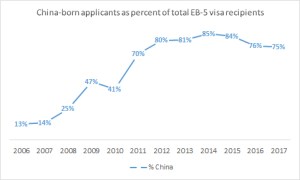At-risk with call option and preferred return? — updated
January 26, 2018 5 Comments
—UPDATES since original post—
10/30/2018: USCIS more or less laid this issue to rest with an update to the USCIS Policy Manual. Regarding redemption provisions only exercisable by the new commercial enterprise, the PM now states that “USCIS generally does not consider these arrangements to be impermissible debt arrangements,” with footnote to Kurzban’s Chang v. USCIS case.
7/9/2018: Ron Klasko explains how his firm is litigating challenges to debt arrangements in the article At Risk, Debt Arrangement, Guaranteed Redemption: Important Distinctions
6/13/2018: IIUSA has included helpful analysis of challenges to investment structures and terms in its letter from IIUSA to USCIS regarding Major Issues Facing the EB-5 Industry.
5/9/2018: Ira Kurzban has published an article based on his success with Chiayu Chang, et. al., v USCIS “Federal Litigation: The Knockout Punch to USCIS’s Overbroad Policy on Redemption Agreements and Call Options?”
FYI here are my notes for an ILW call on 4/17 to discuss the “invest” requirement, and new USCIS challenges to equity with debt-like features. The notes link to the relevant decisions and cases, and summarize the fact pattern and arguments for each case.
4/6/2018: Another lawsuit CHANG et al v. DEPARTMENT OF HOMELAND SECURITY et al (Case Number: 1:18-cv-00659). Here’s a summary and the full complaint.
2/9/2018: I’ve been alerted to a couple district court decisions that rule against USCIS in favor of EB-5 petitioners in cases involving call options.
- Chiayu Chang, et. al., v USCIS 1:16-cv-01740 (Filed 02/07/2018)
…The question in this case is whether United States Citizenship and Immigration Services (USCIS) acted in an arbitrary and capricious manner when it declared plaintiffs ineligible for visas because their investments came with a “call option,” which gave the company in which they invested the choice to buy plaintiffs out. Because the call option at issue here does not provide the investors with any right to repayment, the Court answers this question in the affirmative and grants partial summary judgment to plaintiffs… Unlike a sell option—or a note, bond, or similar arrangement—a buy option provides the investor with no security that she will ever see her money again. …A call option alone does not a debt arrangement make….
(Attorney representing the plaintiffs: Ira J. Kurzban of Kurzban Kurzban Weinger Tatzeli & Pratt, PA)- DOES 1-72 v. UNITED STATES CITIZENSHIP & IMMIGRATION SERVICES et al 1:15-cv-00273 Filed 2/24/2015, decided 03/10/2017
…Importantly, the Call Option was a right exercisable by Quartzburg Gold or its general partner, not the Plaintiff-investors, and the Quartzburg Gold documents made clear that there was no guarantee that it would be exercised. Despite statements that the general partner would strive to be able to exercise this option and buy out the Plaintiff-investors, both the LPA and the Offering Memorandum made clear that “[t]here [was] no guarantee regarding when the Partnership shall exercise such call option, or if such call option shall ever be exercised at all.” …. The Call Option accordingly did not guarantee Plaintiff-investors anything, nor did it have any effect on the risk that the Plaintiff-investors faced that they might lose their capital contributions if the underlying mining projects were not successful… (Attorneys representing the plaintiffs: Robert C. Divine & J. David Folds of Baker Donelson)
— ORIGINAL POST 1/26/2018 —
Every EB-5 offering is a balance between natural investor desire for a return and exit strategy, and EB-5 policy prohibiting debt arrangements between the immigrant investor and new commercial enterprise. (As a reminder, there’s no problem with debt between the NCE and job-creating entities in regional center offerings. The restriction is between the EB-5 investor and NCE.) People who prepare offering documents have to walk a fine line, and should note recent cases that help define where USCIS thinks that line lies.A number of recently-posted cases in the 2017 and 2018 folders I-526 appeals deal with investors in a regional center project who were denied due to a provision in their Limited Partnership Agreement. (See DEC222017_03B7203 as a representative example. Other decisions for the same offering: DEC192017_01B7203, DEC192017_02B7203, DEC222017_01B7203, DEC222017_02B7203, JAN172018_01B7203, JAN172018_04B7203, JAN172018_08B7203, JAN172018_09B7203, JAN172018_10B7203.) Here’s the targeted provision:
Article 9.1 of the partnership agreement provides that at any time on or after the date that a foreign investor’s Form I-829 has been adjudicated, the NCE’s general partner may, in its sole discretion, notify the investor of its desire to purchase (i.e. redeem) his or her interest. The purchase price will include 100 percent of his or her capital contribution ($500.000) plus all accrued and unpaid preferred returns. ….Preferred return is one half of one percent (0.5%) per annum on the total unreturned Capital Contributions [$500.000] of an investor.
Considering the USCIS Policy Manual policy on guaranteed returns and Matter of Izummi, one might think this provision would be acceptable because (1) this provision doesn’t give the investor a right to demand the return (since only the general partner can initiate the buyout), (2) the NCE general partner is not guaranteed to be a willing buyer (since the purchase “may” happen at its sole discretion), and (3) a certain price is not assured (since the purchase itself is not assured). But one would be wrong, according to the analysis by USCIS and the AAO. They found that,
The fact that the general partner has the right to purchase or redeem, which the partnership agreement references as a “buyout right,” rather than the Petitioner having a right to sell his interest is not determinative. We previously found that a sell option was an impermissible debt arrangement regardless of whether it was enforceable.
AAO admits that Matter of Izummi treated a different kind of redemption agreement that gave the Petitioner a sell right, but “the language of the decision goes beyond those facts, explaining not only that the enforceability of the arrangement is immaterial but that an investor may not be assured of receiving a certain price.”
The “certain price” issue is the main leg to stand on for the December 2017 denials. (One wonders about the difference a profit-contingent preferred return would’ve made. Also, the leg still looks pretty weak, considering that the offering apparently lacks the defining feature of debt: fixed obligation to pay.) But the AAO appears to question debt-like elements generally.
A review of the record as a whole reveals an arrangement where once the conditions on the Petitioner’s resident status have been removed, the NCE would likely redeem the Petitioner’s original capital contribution and pay him or her a modest “preferred return,” similar to an interest payment. Such an arrangement, though not characterized as a loan in the offering documents, contains the same elements (principal, interest, repayment period) that one would find in a debt agreement.
AAO concludes,
Considering the partnership agreement and offering memorandum together, we find that the Petitioner did enter into an impermissible debt arrangement with an understanding that the general partner intended to repay the full investment plus preferred returns. This arrangement is not permitted under the broad language at 8 C.F.R. § 204.6(e) (definition of “invest”).
As another example, consider APR182017_01B7203, a 2017 decision that challenges a “Priority Return” in a direct EB-5 offering.
Page 4 of the business plan states that “the NCE will pay the limited partners, if funds are available, a preferred return on their investment, beginning after the EB-5 funds are invested in the project.” As we discussed in our second NOID, Izummi, 22 I&N Dec. at 183-88, provides that if an investor is guaranteed a specific rate of return or the return of his or her investment, then the capital is not at risk, because in essence, the investor has loaned funds to, rather than invested in, the business. See 6 USCIS Policy Manual, supra, at G.2(A)(2).”
Preferred returns on equity investment and buyout provisions are common in EB-5 offerings, and have mostly passed without challenge. I’d be happy to hear analysis of the above non-precedent decisions by someone who can help define (or criticize) the line that USCIS and AAO took in these particular cases. (Thank you, commenters.)
Quotes for reference:
6 USCIS Policy Manual G.2(A)(2)
An arrangement under which funds have been contributed in exchange for an equity interest subject to a redemption agreement which provides that the investor may demand a return of some portion of his or her investment funds, including after obtaining conditional permanent resident status, is an impermissible debt arrangement, no different from the risk any business creditor incurs.
For the alien’s money truly to be at risk, the alien cannot enter into a partnership knowing that he already has a willing buyer in a certain number of years, nor can he be assured that he will receive a certain price. Otherwise, the arrangement is nothing more than a loan, albeit an unsecured one.




